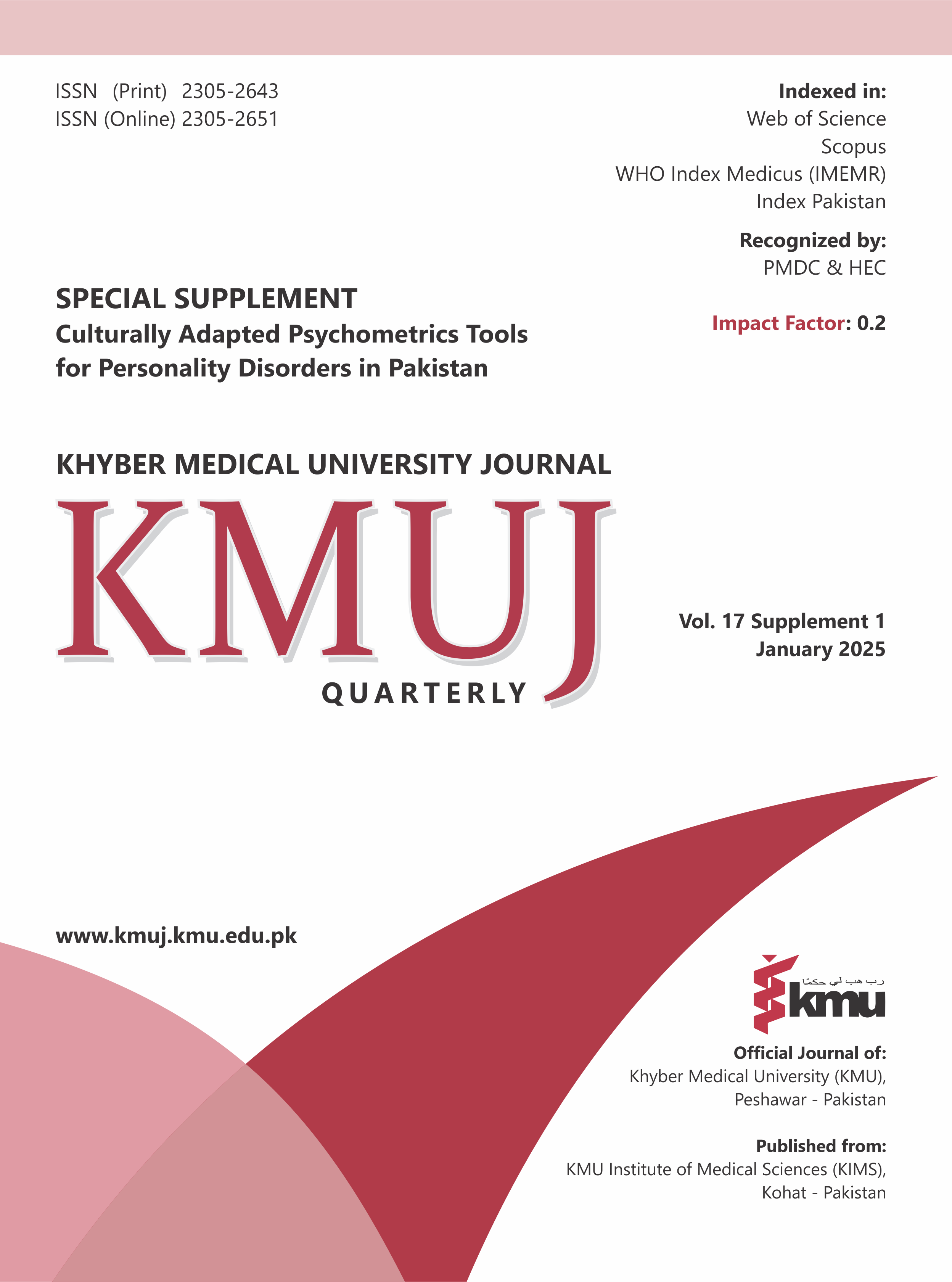Development and psychometric validation of an Urdu-language Obsessive-compulsive personality disorder scale for adults
Main Article Content
Abstract
Objectives: To develop and validate the Obsessive-Compulsive Personality Disorder Scale (OCPDS) for adults in the Urdu language, ensuring its reliability and psychometric soundness within the Pakistani cultural context.
Methods: This cross-sectional analytical study was conducted from February 15 to June 20, 2019, in Gujrat, Pakistan, with ethical approval from University of Gujrat. Using purposive sampling, 234 adults aged 18 years and above (60 clinical, 174 non-clinical; 107 males, 127 females) were recruited from educational, healthcare, and community settings. Scale development followed standardized procedures, beginning with an item pool of 97 questions derived from the DSM-5, existing literature, and expert opinions. The items underwent expert evaluation, a tryout phase, and pilot testing. Exploratory Factor Analysis (EFA) and Confirmatory Factor Analysis (CFA) were applied to finalize the scale. Reliability and validity analyses were conducted using SPSS-21 and AMOS-21.
Results: The final OCPDS comprised 25 items across seven factors: rigidity and stubbornness, inflexibility, preoccupation with details, excessive devotion, hoarding behavior, self-centeredness, and perfectionism. EFA revealed factor loadings between 0.40 and 0.81, while CFA confirmed model fit indices (CFI = 0.919, RMSEA = 0.057). The scale demonstrated excellent reliability (Cronbach's alpha = 0.920) and significant subscale reliabilities (α = 0.688 to 0.899). Convergent validity with the Five Factor Obsessive Compulsive Inventory (FFOCI) yielded a moderate correlation (r = 0.418).
Conclusion: The OCPDS is a psychometrically robust instrument for assessing obsessive-compulsive personality traits in Urdu-speaking adults, with strong reliability, validity, and cultural relevance. It is suitable for clinical and research applications.
Article Details

This work is licensed under a Creative Commons Attribution 4.0 International License.
Work published in KMUJ is licensed under a
Creative Commons Attribution 4.0 License
Authors are permitted and encouraged to post their work online (e.g., in institutional repositories or on their website) prior to and during the submission process, as it can lead to productive exchanges, as well as earlier and greater citation of published work.
(e.g., in institutional repositories or on their website) prior to and during the submission process, as it can lead to productive exchanges, as well as earlier and greater citation of published work.
References
1. American Psychiatric Association. Diagnostic Statistical Manual for Mental Disorders. 5th ed. Arlington, V.A: American Psychiatric Publications 2013;669-71.
2. Dotlich DL, Cairo PC. Why CEOs Fail: The 11 Behaviors That Can Derail Your Climb to the Top - And How to Manage Them. 1st ed. 2007. John Wiley & Sons Inc., New York, USA. ISBN: 9780787967635
3. Cain NM, Ansell EB, Simpson HB, Pinto A. Interpersonal functioning in obsessive–compulsive personality disorder. J Pers Assess 2015;97(1):90-9. https://doi.org/10.1080/00223891.2014.934376
4. Abramowitz JS, McKay D, Taylor S. Obsessive-compulsive disorder : subtypes and spectrum conditions. 1st ed. 2007. Elsevier Science, Amsterdam, Netherlands. ISBN: 9780080550497. https://doi.org/10.1016/B978-0-08-044701-8.X5000-1
5. Lennertz L, Grabe HJ, Ruhrman S, Rampacher F, Vogeley A, Schulze-Rauschenbach S, et al. Perceived parental rearing in subjects with obsessive-compulsive disorder and their siblings. Acta Psychiatr Scand 2010;121(4):280-88. https://doi.org/10.1111/j.1600-0447.2009.01469.x
6. Starcevic V, Berle D, Brakoulias V, Sammut P, Moses K, Milicevic D, et al. Obsessive–compulsive personality disorder co-occurring with obsessive-compulsive disorder: conceptual and clinical implications. Aust N Z J Psychiatry 2012;47(1):65-73. https://doi.org/10.1177/0004867412450645
7. Hummelen B, Wilberg T, Pedersen G, Karterud S. The quality of the DSM-IV obsessive-compulsive personality disorder construct as a prototype category. J Nerv Ment Dis 2008;196(6):446-55. https://doi.org/10.1097/nmd.0b013e3181775a4e
8. Zimmerman M, Rothschild L, Chemlinski I. The prevalence of DSM-IV personality disorders in psychiatric outpatients. Am J Psychiatry 2005;162(10):1911-8. https://doi.org/10.1176/appi.ajp.162.10.1911
9. Rossi A, Marinangeli MG, Butti G, Kalyvoka A, Petruzzi C. Pattern of comorbidity among anxious and odd personality disorders: the case of obsessive–compulsive personality disorder. CNS Spectr 2000;5(9): 23-6. https://doi.org/10.1017/s1092852900021623
10. Tukel R, Ertekin E, Batmaz S, Alyanak F, Sözen A, Aslantaşet B, al. Influence of age of onset on clinical features in obsessive compulsive disorder. Depress Anxiety 2005;21(3):112-7. https://doi.org/10.1002/da.20065
11. Freud S. Character and anal eroticism. In: Strachey J (editor), The standard edition of complete psychological works of Sigmund Freud 1908;9:167-76. Hogarth Press, London
12. Tay L, Jebb A. Scale Development. In: Rogelberg SG (editor), The SAGE Encyclopaedia of Industrial and Organizational Psychology. 2nd ed. 2017. SAGE Publications, New Delhi, India. https://doi.org/10.4135/9781483386874
13. Likert R. A technique for the measurement of attitudes. Arch Psychol 1932;22(140): 5-55.
14. Rahn M. Factor Analysis: A short introduction, part 5–dropping unimportant variables from your analysis 2018. [Accsessed on: July 20, 2019]. Available from URL: https://www.theanalysisfactor.com/fa ctor-analysis-5/
15. Awang Z. Validating the Measurement Model: CFA. In: A Handbook on SEM: Structural equation modelling using amos graphics. 4th ed. 2012:54-73.
16. Gliem JA, Gliem RR. Calculating, interpreting, and reporting cronbach’s alpha reliability coefficient for likert-type scales. Midwest Research to Practice Conference in Adult, Continuing, and Community Education, Columbus 2003;82-88.
17. Griffin SA, Suzuki T, Lynam DR, Crego C, Widiger TA, Miller JD, et al. Development and Examination of the Five-Factor Obsessive-Compulsive Inventory-Short Form. Assessment 2018;25(1):56-68. https://doi.org/10.1177/1073191116643818
18. Worthington RL, Whittaker TA. Scale Development Research: A Content Analysis and Recommendations for Best Practices. Couns Psychol 2006;34(6):806-38. http://dx.doi.org/10.1177/0011000006288127
19. Miller-Carpenter S. Ten steps in scale development and reporting: a guide for researchers. Commun Methods Meas 2018;12(1):25-44. http://dx.doi.org/10.1080/19312458.2017.1396583
20. Samuel DB, Riddell ADB, Lynam DR, Miller JD, Widiger TA. A five- factor measure of obsessive-compulsive personality traits. J Pers Assess 2012;94(5):456-65. https://doi.org/10.1080/00223891.2012.677885
21. Bieling PJ, Israeli AL, Antony MM. Is perfectionism good, bad, or both? Examining models of the perfectionism construct. Pers Individ Differ 2004;36(6):1373-85. https://doi.org/10.1016/S0191-8869(03)00235-6
22. Clark LA. Assessment and diagnosis of personality disorder: Perennial issues and an emerging reconceptualization. Annu Rev Psychol 2007;58:227-57. https://doi.org/10.1146/annurev.psych.57.102904.190200
